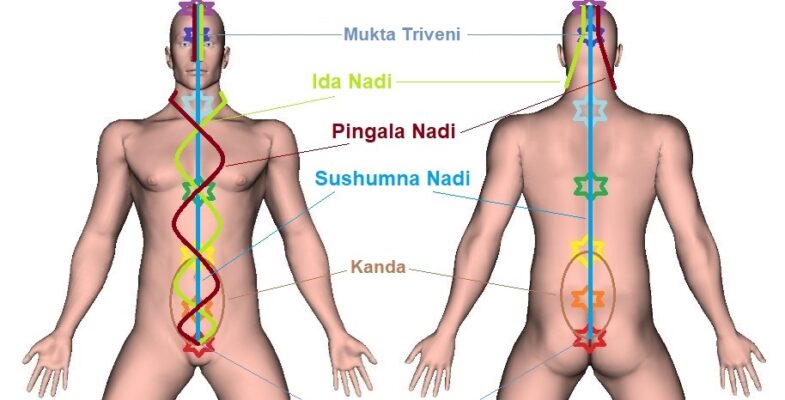
As we know, the actual number of Nadis in the body is not ten, fourteen, or seventy-two, but much more, said to be 72 000, 350 000, millions, or even uncountable.
The classical scriptures about Yoga often claim that the Prana Nadis run everywhere in the entire body, like a grid, an extensive network that looks like the warp and woof of cloth, a tree with branches, twigs, leaves, and the nerves of the leaves, or alternatively as the countless rays of the sun, and so on.

In fact, the principal fourteen Nadis branch out to many other Nadis, that is, they have many extensions, branches and sub-branches so that the Prana network finally traverses the entire body, reaching every single cell.
As stated in the Shiva Samhita text: “From all these fourteen Nadis, there arise gradually other branches and sub-branches, so that at last they become three hundred thousand and a half in number, and supply their respective places.”
We can get a better idea of the Nadi branches and sub-branches when we look at the Sib Sen Energy Lines in Thai Massage. Unlike the Nadis, the extensions and branches of the ten principal Sen Energy Channels are well-documented, and as the Sen Energy Line system is significantly based on the Yoga Nadi system it makes great sense to study them.
In Sen Line theory, extensions are directly connected to a main Sen Line, and branches can be connected to the main Sen Lines or to Sen Line extensions.
What constitutes an extension or branch of a certain Sib Sen Line is the fact that they have the same therapeutic or functional indications as the main Sen Line they (belong to or) are to be counted to.
Thus, when we study the classical texts that mention the Yoga Nadis, you’ll often find that several, seemingly contradictory intermediary and ending points are mentioned for the same Nadi. One reason to this is most likely the reference to intermediary and/or ending points of important extensions or branches of a particular Nadi.

This would explain rather conflicting statements, such as “Hastijihva Nadi goes to the big toe of the left foot (Darshana Upanishad)” and “Hastijihva is on the right eye (Goraksha Samhita).”
Or, to give another example: “Pusha is on the right side occupying behind Pingala upwards and up to the right eye (Vasistha Samhita)” and “Pusha Nadi stands in the right ear (Yoga Chudamani Upanishad).”
Unfortunately, the classical texts don’t elaborate on branches and extension of the main Nadis, apart from occasionally mentioning seemingly totally unrelated intermediary, traversing, or ending points. Of course, this doesn’t help to make the Nadi trajectory system more comprehensible, to say the least.
It is what it is, surely, and the only thing we can mention here is that the study of the Sip Sen Lines infrastructure can come of help to having a better grasp of possible i.e. potential extensions and branches of the principal fourteen Nadis.















